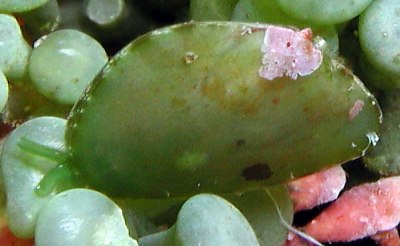
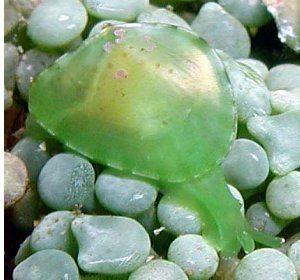
Tamanovalva limax
Kawaguti & Baba, 1959
Order: SACOGLOSSA
Superfamily: OXYNOOIDEA
Family: Juliidae
DISTRIBUTION
Known only from Japan, but possibly has a wider distribution.
PHOTO
Hachijo Island Japan, Depth: 8m, Length: 5mm. Photos: Nishina Masayoshi
This animal was the first living bivalved gastropod to be discovered. Shells of related animals had been known from both fossil and recent deposits and had usually been considered to be an unusual bivalve although some authors had noted the gastropod like larval shell on one valve. There is some uncertainty about which generic names should be used for this species. This is discussed in a separate message. It is reported to feed on Caulerpa okamurai.
References:
• Kawaguti, S. & Baba, K. (1959) A preliminary note on a two-valved sacoglossan gastropod, Tamanovalva limax, n. gen., n. sp., from Tamano, Japan. Biol. J. Okayama Univ. 5(3-4): 177-184.
• Baba, K (1961) On the identification and the affinity of Tamanovalva limax, a bivalved sacoglossan mollusc in Japan. Publications of the Seto Marine Biological Laboratory, 9: 37-62, Pls 1-4.
• Baba, K. (1961) The shells and radulae in Berthelinia, a bivalved sacoglossan genus. Venus, The Japanese Journal of Malacology, 21: 389-401, text-figs 1-4, Pl. 21.
Rudman, W.B., 2002 (March 11) Tamanovalva limax Kawaguti & Baba, 1959. [In] Sea Slug Forum. Australian Museum, Sydney. Available from http://www.seaslugforum.net/find/tamalima
Related messages
Re: Tamanovalva limax from southern Queensland
May 11, 2007
From: Denis Riek
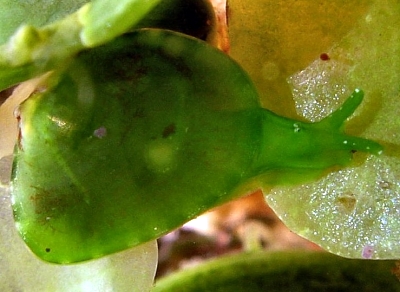

Concerning message #19650:
Dear Bill,
Here are some more images of Tamanovalva limax from a little further south than Gary's. It was found at Hastings Point, Northern New South Wales just below low tide mark on Caulerpa peltata
Locality: Hastings Point, 1 metre, Northern New South Wales, Australia, Pacific, 13 September 05, On Caulerpa peltata on rock reef. Length: 4mm. Photographer: Denis Riek.
Cheers
Denis
http://www.roboastra.com
dwriek@optusnet.com.au
Riek, D.W., 2007 (May 11) Re: Tamanovalva limax from southern Queensland. [Message in] Sea Slug Forum. Australian Museum, Sydney. Available from http://www.seaslugforum.net/find/19891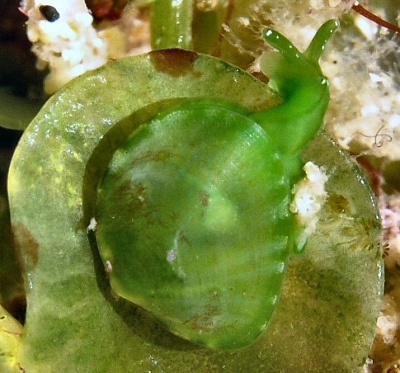
Dear Denis,
I always have room for photos of the amazing animals.
Best wishes,
Bill Rudman
Tamanovalva limax from New Caledonia
April 10, 2007
From: Bill Rudman
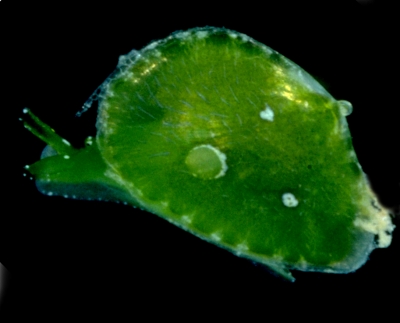
To accompany Gary Cobb's message [#19650], here is a record of Tamanovalva limax from New Caledonia
Lagoon between mainland and Récif de l'Infernet, off Koumac, New Caledonia, 20°34.4'S, 164°13'E, 12m, Silty bottom with dense gorgonian beds, with some Caulerpa racemosa. 4 October 1993, 1 specimen (5 mm long extended), AM C200337.
Best wishes
Bill Rudman
Tamanovalva limax from southern Queensland
April 6, 2007
From: Gary Cobb


Hi Bill and everyone!
My dive buddy David Mullins and I have been collecting Caulerpa racemosa and have found some new exciting animals. I thought I would update the Forum fact sheet file for Tamanovalva limax. I found it within the Caulerpa after we went diving.
Locality: Mooloolaba Sunshine Coast, 18m, Queensland, Pacific Ocean, 10 March 2007, Subtidal. Length: 7 mm. Photographer: Gary Cobb.
Cheers and happy branching!
Gary Cobb
gary@nudibranch.com.au
Cobb, G.C., 2007 (Apr 6) Tamanovalva limax from southern Queensland. [Message in] Sea Slug Forum. Australian Museum, Sydney. Available from http://www.seaslugforum.net/find/19650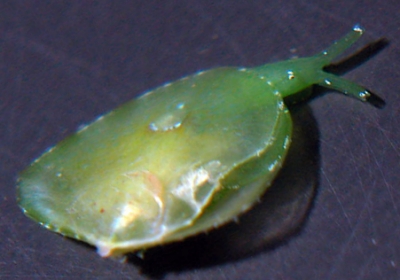
Thanks Gary,
I love these little 'bivalved snails'. Until living animals were found, members of the family, which was first found in the the fossil record, were thought to be strange bivalves. I am not quite sure why I haven't photos of this species from the southern Pacific on the Forum - I have certainly found it on the Great Barrier Reef and New Caledonia. I must look out some photos.
Best wishes,
Bill Rudman
Another photo of Tamanovalva limax
June 12, 2002
From: Nishina Masayoshi

Dear Bill,
Here is a another photo of Tamanovalva limax. I personally have no idea about the differences between Berthelinia schlumbergeri and T. limax.
Date:2002 April 6
Location:Hachijo Island Japan
Depth:8m
Length:8mm
Photo by N.Masayoshi
Best Regards,
Nishina Masayoshi
http://umiushi.zive.net/index.html
nishina@wips.co.jp
Masayoshi, N., 2002 (Jun 12) Another photo of Tamanovalva limax. [Message in] Sea Slug Forum. Australian Museum, Sydney. Available from http://www.seaslugforum.net/find/6843Thanks Nishina,
Concerning the difference between Berthelinia schlumbergeri and Tamanovalva limax all I can do is refer you to my .earlier comments on the genera of bivalved sacoglossans. I am basically following The Southern Synthesis in accepting existing genera until someone suggests a reasonable alternative.
Best wishes,
Bill Rudman
Is this Tamanovalva or Berthelinia?
March 12, 2002
From: Nishina Masayoshi

Dear Bill,
Would you let me know the name of this species? Is this Tamanovalva or Berthelinia?
Date: 3 March, 2002
Location: Hachijo Island Japan
Depth: 8m
Length: 5mm
Best Regards,
Nishina Masayoshi
http://umiushi.zive.net/index.html
nishina@wips.co.jp
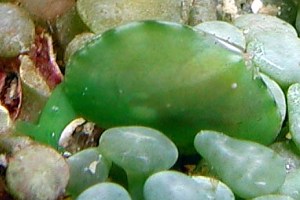

Dear Nishina,
As I said in my answer to Atsushi Ono, the question of which generic name to use is very difficult to decide. Personally I have difficulty in using the fossil name Berthelinia, as we have no way of determining if the animals that made the fossil shells are really closely related to any living species. The situation is further complicated because it is possible that that Edenttellina typica, which is the earliest name for a living species may be congeneric with Tamanovalva. I don't think there is any purpose in just assuming that all these species are congeneric so my feeling is that we should continue to call this animal Tamanovalva limax until an anatomical review of the living species is conducted. That is why I have continued to use Midorigai and Edenttellina for the Australian species. Without evidence it is no more sensible to say they are the same as it is to say they are different. As I said earlier, I would welcome some other opinions on this.
Best wishes,
Bill Rudman.
